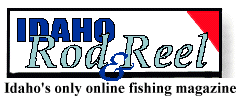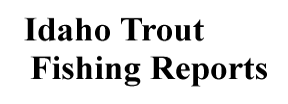|
|
![]() Rainbow trout are the most widespread trout in Idaho, occurring naturally in most
major drainages and introduced wherever else habitat will support them.
Generally, if the water holds trout, the hardy rainbow will be among them. Golden trout・found only
in a few high mountain lakes in the Sawtooths, Bitterroots and Lemhis・are
a variant of rainbow. So are the fast-growing, sometimes-giant kamloops
of the big north Idaho lakes and a few other secret holes such as Lake
Walcott in the south central part of the state. In a few waters including
Henrys Lake, rainbows have crossed with cutthroat trout to create the colorful
and vigorous hybrid "cuttbow".
Rainbow trout are the most widespread trout in Idaho, occurring naturally in most
major drainages and introduced wherever else habitat will support them.
Generally, if the water holds trout, the hardy rainbow will be among them. Golden trout・found only
in a few high mountain lakes in the Sawtooths, Bitterroots and Lemhis・are
a variant of rainbow. So are the fast-growing, sometimes-giant kamloops
of the big north Idaho lakes and a few other secret holes such as Lake
Walcott in the south central part of the state. In a few waters including
Henrys Lake, rainbows have crossed with cutthroat trout to create the colorful
and vigorous hybrid "cuttbow".
![]() Cutthroat trout come in several variations including the Westslope, Yellowstone,
and Bonneville strains. All cutthroats are distinguished by red slashes
under their lower jaws, hence the name. They demand the best in water
quality and are usually aggressive about taking whatever the angler throws
their way. Because of this eagerness to bite, they must be protected by
special regulations in much of their range (note special cutthroat regulations,
which vary from region to region). Where they are abundant, cutthroats
offer some of the hottest catch-and-release wild trout action any angler
could ask.
Cutthroat trout come in several variations including the Westslope, Yellowstone,
and Bonneville strains. All cutthroats are distinguished by red slashes
under their lower jaws, hence the name. They demand the best in water
quality and are usually aggressive about taking whatever the angler throws
their way. Because of this eagerness to bite, they must be protected by
special regulations in much of their range (note special cutthroat regulations,
which vary from region to region). Where they are abundant, cutthroats
offer some of the hottest catch-and-release wild trout action any angler
could ask.
![]() Brown trout grow to good size in many Idaho waters, tending to do well in larger
streams, often where temperature and clarity does not quite measure up
to the standards demanded by rainbow or cutthroat. In some streams and
lakes, they share habitat with rainbows. Monster browns lurk in the tailraces
of big dams including Palisades and American Falls in southeastern Idaho,
but one of the biggest Idaho browns was caught from the Boise River within the
limits of the capitol city. The Little Wood River in the desert of south
central Idaho is famous among flyfishermen for its browns.
Brown trout grow to good size in many Idaho waters, tending to do well in larger
streams, often where temperature and clarity does not quite measure up
to the standards demanded by rainbow or cutthroat. In some streams and
lakes, they share habitat with rainbows. Monster browns lurk in the tailraces
of big dams including Palisades and American Falls in southeastern Idaho,
but one of the biggest Idaho browns was caught from the Boise River within the
limits of the capitol city. The Little Wood River in the desert of south
central Idaho is famous among flyfishermen for its browns.
 Brook trout, native to the eastern U.S., do well in higher elevation Idaho waters
from small streams to alpine lakes but the largest may be found in Henrys
Lake. In many waters, brookies reproduce all too well and stunting occurs
where there is not enough fishing pressure or predators. Watch regulations
for areas where a special bonus limit of brookies is offered. No catch-and-release
on these little guys; eat ・em! One of the best-tasting of all trout or
char species, this is not a challenge.
Brook trout, native to the eastern U.S., do well in higher elevation Idaho waters
from small streams to alpine lakes but the largest may be found in Henrys
Lake. In many waters, brookies reproduce all too well and stunting occurs
where there is not enough fishing pressure or predators. Watch regulations
for areas where a special bonus limit of brookies is offered. No catch-and-release
on these little guys; eat ・em! One of the best-tasting of all trout or
char species, this is not a challenge.
![]() Bull trout (a.k.a. Dolly Varden) are, like the brook trout and lake trout, really
a char and not a trout. There is at this time no legal harvest of bull
trout in the State of Idaho. Bull trout are in trouble throughout most
of their range in the northern Rockies. Idaho anglers and fisheries managers
are trying to recover this native fish before it goes on the Endangered
Species list.
Bull trout (a.k.a. Dolly Varden) are, like the brook trout and lake trout, really
a char and not a trout. There is at this time no legal harvest of bull
trout in the State of Idaho. Bull trout are in trouble throughout most
of their range in the northern Rockies. Idaho anglers and fisheries managers
are trying to recover this native fish before it goes on the Endangered
Species list.
![]() Lake trout fishing rewards the specialized angler equipped to fish deep in big
water. The huge lakes of north Idaho and Bear Lake in the southeast corner are
well-known as lake trout waters. A few smaller lakes including Payette
Lake and Warm Lake in the western mountains contain lake trout as well
but there is a special 36-inch minimum at Payette Lake to protect the spawning
stock there. The specialized equipment and knowledge necessary for successful
lake trout fishing makes going with an outfitter, at least the first time,
the best chance of seeing some action.
Lake trout fishing rewards the specialized angler equipped to fish deep in big
water. The huge lakes of north Idaho and Bear Lake in the southeast corner are
well-known as lake trout waters. A few smaller lakes including Payette
Lake and Warm Lake in the western mountains contain lake trout as well
but there is a special 36-inch minimum at Payette Lake to protect the spawning
stock there. The specialized equipment and knowledge necessary for successful
lake trout fishing makes going with an outfitter, at least the first time,
the best chance of seeing some action.
![]() Grayling are not trout but they are taken from the same waters by the same methods
and are highly regarded by most trout anglers. Grayling were transplanted
into high mountain lakes long ago but prospered in only a few. Those remote
lakes, like the locations of golden trout, are closely guarded secrets
among anglers and are not publicized by the Department of Fish and Game.
The determined and stout of leg can try the gorgeous little lakes in the
Sawtooths and Lemhis.
Grayling are not trout but they are taken from the same waters by the same methods
and are highly regarded by most trout anglers. Grayling were transplanted
into high mountain lakes long ago but prospered in only a few. Those remote
lakes, like the locations of golden trout, are closely guarded secrets
among anglers and are not publicized by the Department of Fish and Game.
The determined and stout of leg can try the gorgeous little lakes in the
Sawtooths and Lemhis.


